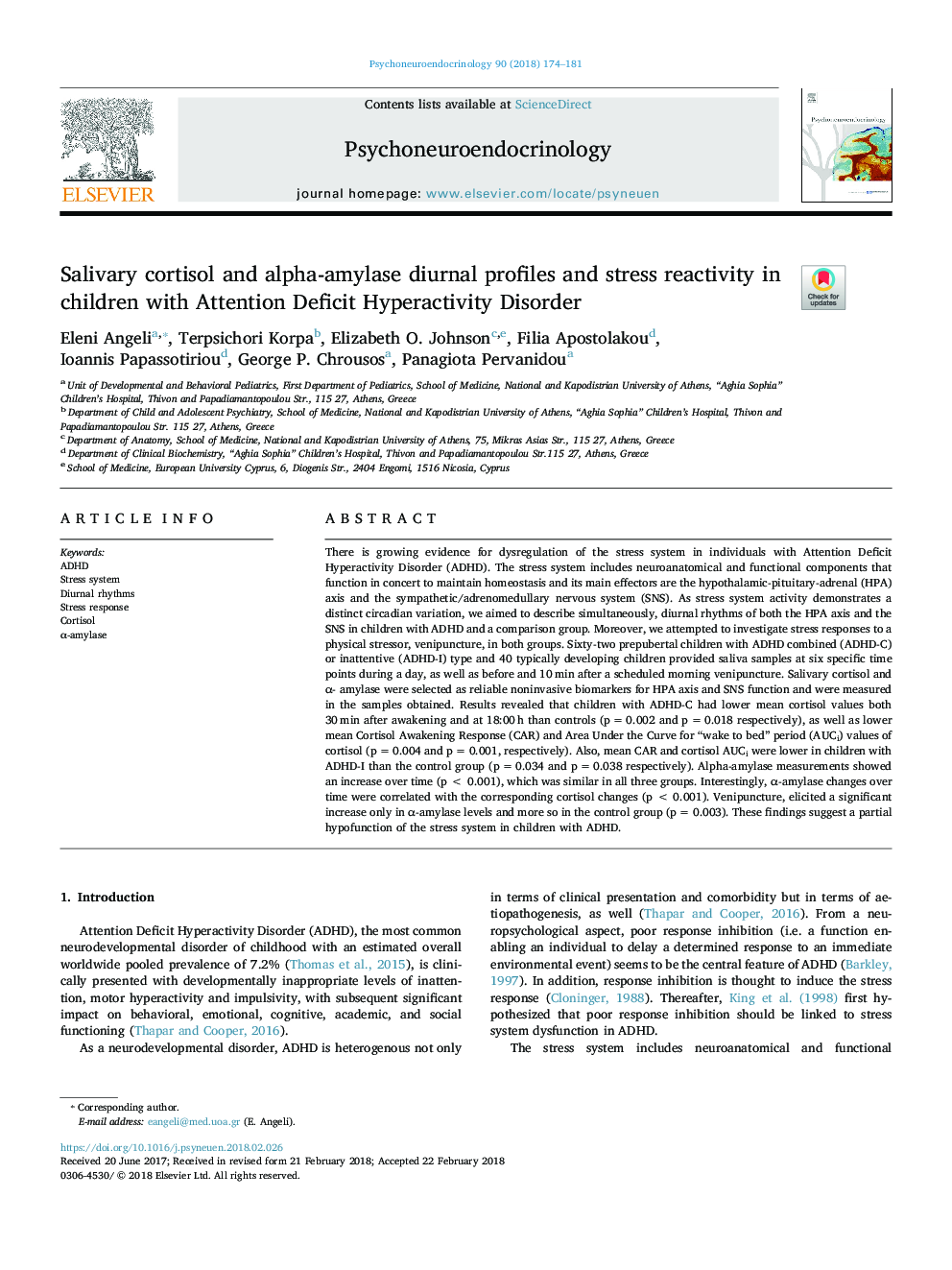| کد مقاله | کد نشریه | سال انتشار | مقاله انگلیسی | نسخه تمام متن |
|---|---|---|---|---|
| 6817725 | 1433953 | 2018 | 8 صفحه PDF | دانلود رایگان |
عنوان انگلیسی مقاله ISI
Salivary cortisol and alpha-amylase diurnal profiles and stress reactivity in children with Attention Deficit Hyperactivity Disorder
ترجمه فارسی عنوان
پروفایل کورتیزول بزاقی و آلفا آمیلاز روزانه و واکنش پذیری تنش در کودکان مبتلا به اختلال بیش فعالی کمبود توجه
دانلود مقاله + سفارش ترجمه
دانلود مقاله ISI انگلیسی
رایگان برای ایرانیان
کلمات کلیدی
بیش فعالی، سیستم استرس، ریتم های روزانه، پاسخ استرس، کورتیزول، ą-آمیلاز،
موضوعات مرتبط
علوم زیستی و بیوفناوری
بیوشیمی، ژنتیک و زیست شناسی مولکولی
علوم غدد
چکیده انگلیسی
There is growing evidence for dysregulation of the stress system in individuals with Attention Deficit Hyperactivity Disorder (ADHD). The stress system includes neuroanatomical and functional components that function in concert to maintain homeostasis and its main effectors are the hypothalamic-pituitary-adrenal (HPA) axis and the sympathetic/adrenomedullary nervous system (SNS). As stress system activity demonstrates a distinct circadian variation, we aimed to describe simultaneously, diurnal rhythms of both the HPA axis and the SNS in children with ADHD and a comparison group. Moreover, we attempted to investigate stress responses to a physical stressor, venipuncture, in both groups. Sixty-two prepubertal children with ADHD combined (ADHD-C) or inattentive (ADHD-I) type and 40 typically developing children provided saliva samples at six specific time points during a day, as well as before and 10â¯min after a scheduled morning venipuncture. Salivary cortisol and α- amylase were selected as reliable noninvasive biomarkers for HPA axis and SNS function and were measured in the samples obtained. Results revealed that children with ADHD-C had lower mean cortisol values both 30â¯min after awakening and at 18:00â¯h than controls (pâ¯=â¯0.002 and pâ¯=â¯0.018 respectively), as well as lower mean Cortisol Awakening Response (CAR) and Area Under the Curve for “wake to bed” period (AUCi) values of cortisol (pâ¯=â¯0.004 and pâ¯=â¯0.001, respectively). Also, mean CAR and cortisol AUCi were lower in children with ADHD-I than the control group (pâ¯=â¯0.034 and pâ¯=â¯0.038 respectively). Alpha-amylase measurements showed an increase over time (pâ¯<â¯0.001), which was similar in all three groups. Interestingly, α-amylase changes over time were correlated with the corresponding cortisol changes (pâ¯<â¯0.001). Venipuncture, elicited a significant increase only in α-amylase levels and more so in the control group (pâ¯=â¯0.003). These findings suggest a partial hypofunction of the stress system in children with ADHD.
ناشر
Database: Elsevier - ScienceDirect (ساینس دایرکت)
Journal: Psychoneuroendocrinology - Volume 90, April 2018, Pages 174-181
Journal: Psychoneuroendocrinology - Volume 90, April 2018, Pages 174-181
نویسندگان
Eleni Angeli, Terpsichori Korpa, Elizabeth O. Johnson, Filia Apostolakou, Ioannis Papassotiriou, George P. Chrousos, Panagiota Pervanidou,
